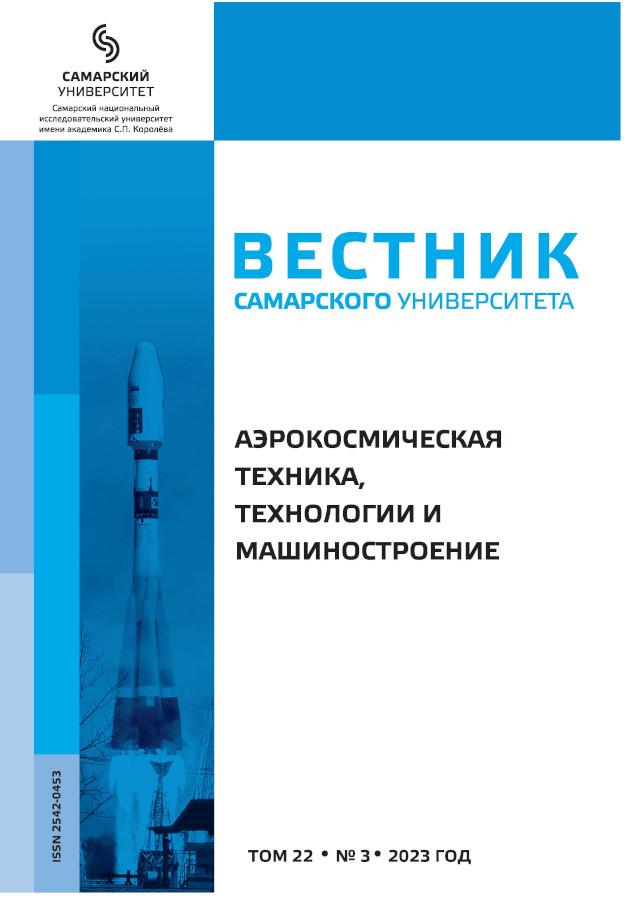Digital model of the drag force of the Earth’s upper atmosphere for the design of low-orbit spacecraft
- Authors: Volotsuev V.V.1
-
Affiliations:
- Samara National Research University
- Issue: Vol 22, No 3 (2023)
- Pages: 13-24
- Section: AIRCRAFT AND SPACE ROCKET ENGINEERING
- URL: https://journals.ssau.ru/vestnik/article/view/26885
- DOI: https://doi.org/10.18287/2541-7533-2023-22-3-13-24
- ID: 26885
Cite item
Full Text
Abstract
A digital model is described for estimating the drag force of the Earth's upper atmosphere acting on a low-orbit spacecraft. Unlike the classical model of aerodynamic force, the digital model is the result of a computer algorithm. This algorithm calculates the field of aerodynamic force values, taking into account changes in the flight altitude, aerodynamic coefficient and the area of the spacecraft midsection over time. The calculations also use a digital model of the dynamic density of the Earth's upper atmosphere. The digital model of the drag force of the Earth's upper atmosphere is useful in the design of low-orbit spacecraft with a low-thrust jet propulsion system (thrust order – millinewtons). On the basis of the calculated values of the aerodynamic force, it is possible to form requirements for the geometry of the spacecraft, attitude modes and arrangement of low-thrust jet engines (for example, electric jet engines). With the accumulation of big data in the form of tabular functions of aerodynamic force from the space of various design and ballistic parameters of low-orbit spacecraft, it is possible to create a machine model (ML-model). It will make forecasts of the values of the design characteristics for the low-orbit spacecraft being developed according to a limited set of initial requirements.
About the authors
V. V. Volotsuev
Samara National Research University
Author for correspondence.
Email: volotsuev@mail.ru
ORCID iD: 0000-0001-8784-430X
Candidate of Science (Engineering), Associate Professor, Department of Space Mechanical Engineering named after General Designer D.I. Kozlov
Russian FederationReferences
- Kirilin A.N., Anshakov G.P., Akhmetov R.N., Storozh D.A. Kosmicheskoe apparatostroenie: Nauchno-tekhnicheskie issledovaniya i prakticheskie razrabotki GNPRKTs «TsSKB-Progress» [Space hardware engineering: Scientific and technical research and practical studies of GNPRCC TSSKB-Progress]. Samara: Izdatel'skiy Dom «AGNI», 2011. 280 p.
- PlanetScope. Available at: https://innoter.com/sputniki/planetscope
- Abalakin V.K., Aksenov E.P., Grebenikov E.A., Demin V.G., Ryabov Yu.A. Spravochnoe rukovodstvo po nebesnoy mekhanike i astrodinamike [Reference guide to celestial mechanics and astrodynamics]. Moscow: Nauka Publ., 1976. 864 p.
- Kovtunenko V.M., Kameko V.F., Yaskevich E.P. Aerodinamika orbital'nykh kosmicheskikh apparatov [Aerodynamics of orbital spacecraft]. Kiev: Naukova Dumka Publ., 1977. 156 p.
- GOST R25645.115-84. Earth upper atmosphere. Density model for ballistics support of flights of artificial Earth satellites. Moscow: Izdatel'stvo Standartov Publ., 1991. 31 p.
- GOST R25645.166-2004. Earth upper atmosphere. Density model for ballistic support of flights of artificial Earth satellites. Moscow: Izdatel'stvo Standartov Publ., 2004. 24 p.
- Pervushin A. Koshmar «Skayleba» [Skylab's Nightmare]. Available at: https://warspot.ru/19561-koshmar-skayleba?ysclid=ldx0hsmmc4525526033
Supplementary files






















